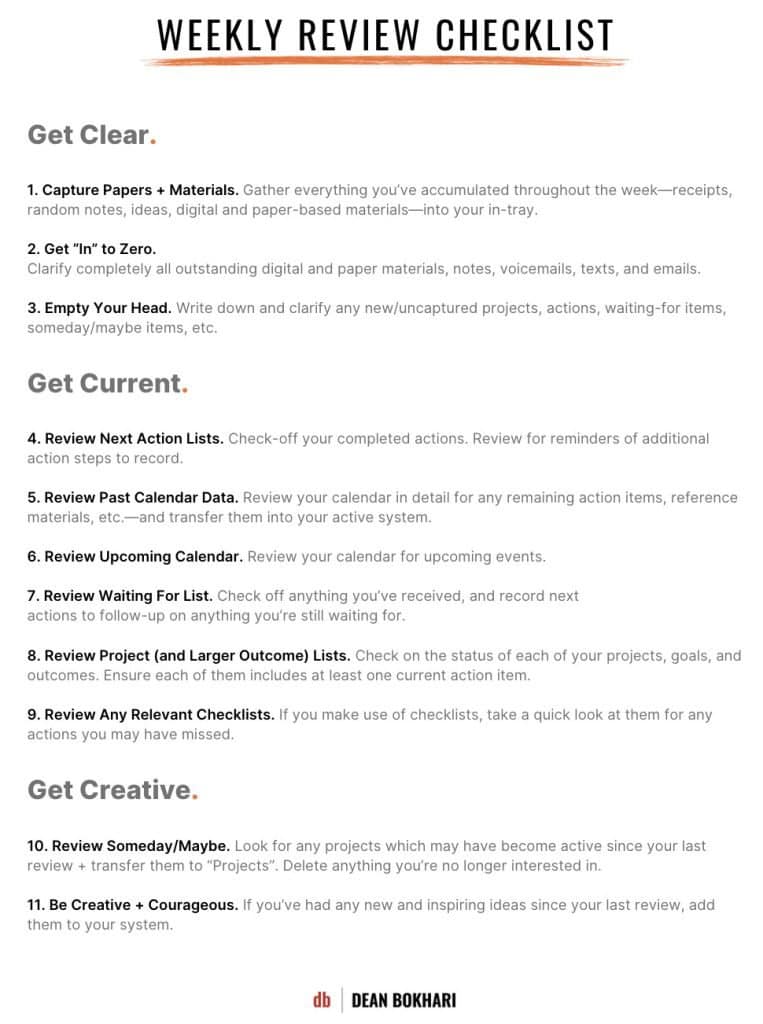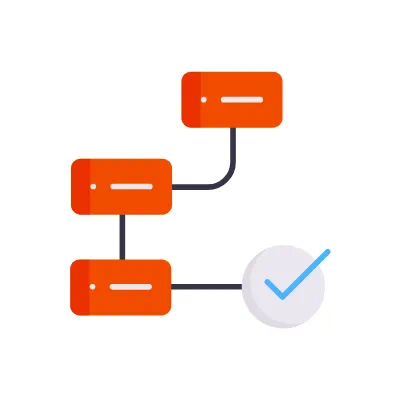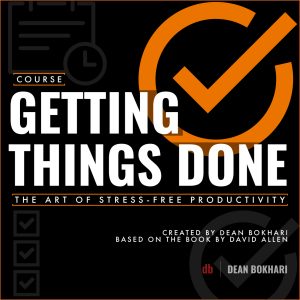11: How to Conduct a Weekly Review
- Welcome to Lesson 11!
- 🎧 Press Play to start this lesson.
- 📖 Scroll down to follow along.
Lesson summary
“Best to not be too tied up in how often you “should” be doing a Weekly Review. Then, like avoiding writing your relatives because there’s just too much to catch up on, if you’re not getting to the Review regularly, you’ll just think it’s too much to catch up with, and you quit. Any time, any frequency, is better than not at all.” —David Allen
The GTD Weekly Review is what ties the whole system together, ensuring that you’ve got actions attached to all of your active projects on a consistent basis, so you can trust that what you’re choosing from your next action lists is current.
Here are a few things you should include in your weekly review:
- ✓ Clarify + organize – anything you’ve collected but haven’t handled yet.
- ✓ Review your active tasks – are there any to add, delegate, defer, or delete?
- ✓ Review your active projects – are there any to add, delegate, defer, or delete?
- ✓ Review your calendar – are there any meetings to add, delegate, defer, or delete?
- ✓ Someday/Maybe – anything to add or promote to an active project?
- ✓ Reference Files – anything you need soon? Anything to add or update?
- ✓ Goals – are you moving in the right direction? Are you making progress? Are any changes necessary?


(Find + download this checklist in the Materials tab)
The 11 steps of a successful weekly review
Here are all 11 steps to the GTD Weekly Review, for your reference:
Get clear.
- 1: Capture Papers + Materials. Gather everything you’ve accumulated throughout the week—receipts, random notes, ideas, and other digital and paper-based materials—into your in-tray.
- 2: Get “In” to Zero. Clarify all outstanding paper materials, notes, voicemails, texts, and emails.
- 3: Empty Your Head. Write down and clarify any new/uncaptured projects, actions, waiting-for items, someday/maybe items, etc.
Get current.
- 4: Review Next Action Lists. Check off your completed actions. Review for reminders of additional action steps to record.
- 5: Review Past Calendar Data. Review your calendar in detail for any remaining action items, reference materials, etc., and transfer them into your active system.
- 6: Review Upcoming Calendar. Review your calendar for upcoming events.
- 7: Review Waiting For List. Check off anything you’ve received, and record next actions to follow-up on anything you’re still waiting for.
- 8: Review Project (and Larger Outcome) Lists. Check on the status of each of your projects, goals, and outcomes. Ensure each of them includes at least one current action item.
- 9: Review Any Relevant Checklists. If you make use of checklists, take a quick look at them for any actions you may have missed.
Get creative.
- 10: Review Someday/Maybe. Look for any projects which may have become active since your last review and transfer them to “Projects”. Delete anything you’re no longer interested in.
- 11: Be Creative + Courageous. If you’ve had any new and inspiring ideas since your last review, add them to your system.
Actionable insights
- Making a habit out of conducting a weekly review can take significant upfront time + effort, but the pay-off is worth it.
- If you’re not doing a weekly review, you’re not doing GTD. So, stick with and stay consistent—it’ll keep your productivity system (and your mind) clean and current, so that you can experience the stress-free productivity that GTD is famous for.
Exercise
- Download the Weekly Review Checklist from the Materials tab of this lesson. Then, pin it up to use as a quick reference guide as you conduct your own weekly reviews.
- Select one day each week to conduct your weekly review, and block it off as a recurring event in your calendar. For the first few weeks, block off 1.5–2 hrs.
- Once it becomes natural, cut it down to 30–60 minutes.
- No matter what happens—NEVER skip your weekly review. Just one hour of planning can save you 10 hours of doing. Pick a day, block it off on your calendar, and be viciously protective about making it happen.


